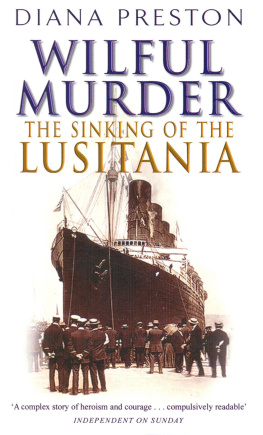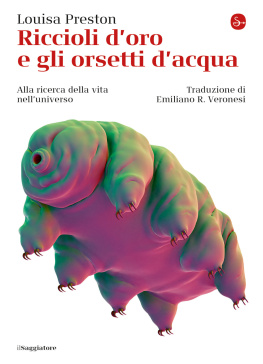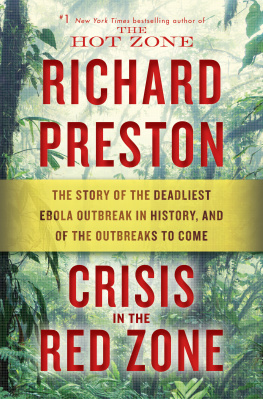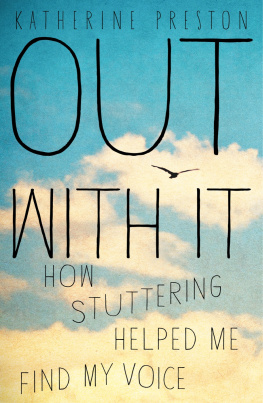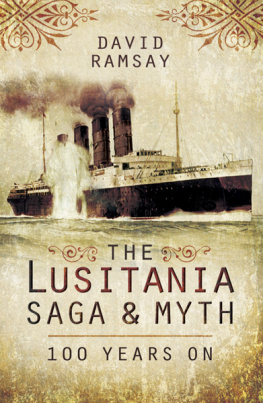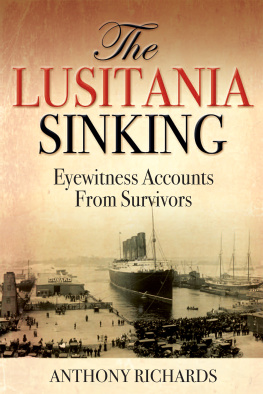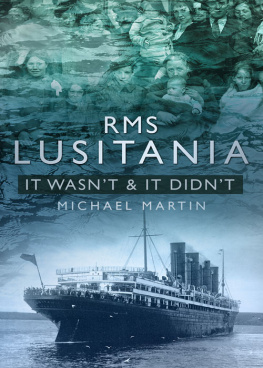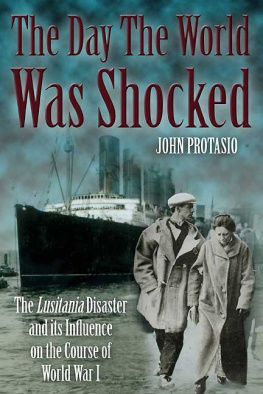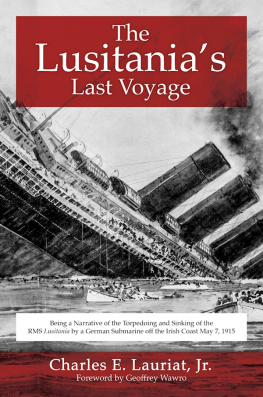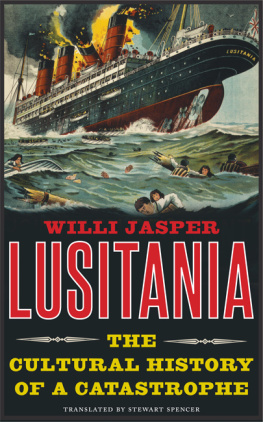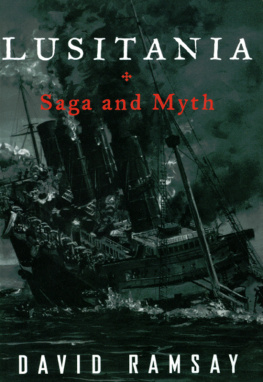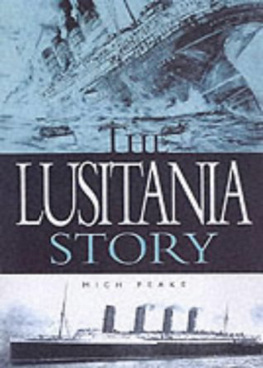WILFUL MURDER
THE SINKING OF THE LUSITANIA
DIANA PRESTON
Doubleday edition published 2002
Copyright Diana Preston 2002
To my husband Michael

CONTENTS
Prologue:Gone in Eighteen Minutes
ITROUBLED WATERS
1 AScrap of Paper
2 TheWeapon of the Weaker Nation
3 MoreBeautiful than Solomons Temple
Gott Strafe England !
5 TheAmerican Armoury
IIFINAL CROSSING
6 TheWarning
7Leaving Harbour
8 TheOstrich Club
9Fellow Passengers
10Inside the U-20
11 TheMiraculous Draught of Fishes
12 Intothe War Zone
13Suppose They Should Sink the Lusitania ... ?
III ANOCEAN RED WITH BLOOD
14 MyGod... We Are Lost
15 Ratsin the Dark
16 ABizarre Orchestra of Death
Wave upon Wave
18 ALong, Lingering Moan
19Rescues and Recoveries
20 TheTown of the Dead
21 ASad and Horrible Task
IVREMEMBER THE LUSITANIA !
22 TheHuns Most Ghastly Crime
23 Foolor Traitor?
24 NoLonger Neutral Spectators
25German Agents Are Everywhere
26 TheKaisers Business Only
27That Story Is Forever Disposed Of
28 Divinginto the Wreck
VWILFUL MURDER?
29 ALegitimate Target?
30Harms Way
31Anglo-Saxon Attitudes
32 TheU-Boat Diary
33 ASullen Rumble
Epilogue:A New Barbarism
ACKNOWLEDGEMENTS
The story of the Lusitania is one of many people of many nationalitiescaught in a sweep of extraordinary events. I am grateful to my husband Michael,my partner in writing as in life, for the idea of telling that story and for hiswork on all aspects of the project. It was he who suggested that I stand, for justa few minutes, in the sea near Cobh while we were researching in Ireland. It wasalmost exactly the time of year when the Lusitania sank and the numbing coldness of the waterbrought home to me what it must have been like for her passengers and crew on 7May 1915.
I am indebted to several individuals and organisationsin the UK for their help and expertise, in particular Dr Mike Wood for his analysisof the causes and effects of the explosions on board the Lusitania ; Donald Wallace FRCS and Dr Ingrid Wallacefor advice on the physiological effects of hypothermia; Peter Allmond of the BodleianLibrary, who traced a number of rare books; and Adrian Allan of Liverpool Universitywho helped us find our way through the Cunard archives and guided us to other sourcesof information. I am also grateful to the staff and archivists of the British Library,the London Library, Churchill College, Cambridge, the National Maritime Museum,the Merseyside Maritime Museum, the Public Record Office and the BBC Written ArchivesCentre. I must also thank Iain MacKenzie of the Ministry of Defence for help withdeclassification of official files and access to new documents; Simon Baker of theBritish Film Institute for information about The Carpet from Bagdad ; Mark Jones, who has recently dived on thewreck; and Audrey Lawson-Johnson, survivor of the Lusitania , for her encouragement.
In the USA I am grateful to Ronald Bulatoff of the HooverInstitution, Stanford University, for guiding us through the extensive Bailey-Ryanarchive; Mary Hoehling, who generously pointed me in the direction of material sheand her husband had deposited with the Mariners Museum, Newport News, Virginia,whose archivist Heather Friedle was extremely helpful; Lily Bardi-Ullmann, who trackeddown rare books, researched meticulously and unstintingly through archives in NewYork and translated key German documents; and Professor John Hattendorf of the Naval War College, Newport, Rhode Island,for his help in tracing documents.
In Germany I would like to thank Frau Zandeckof the Militrarchiv in Freiburg for helping touncover new material from German naval files, and Frau Weisbach-Zerning, widow ofthe U-20 s torpedo officer Raimund Weisbach, for her recollections. I am also grateful toHolger Nehring of Tbingen and Oxford Universities forhis extensive research in the German archives and into the history of Charles Voegelein Strasbourg, and to the Traditionsarchiv Unterseeboote in Cuxhaven for making material availableto him.
In Canada I must thank the CBC, in particularKen Puley, for allowing me access to their taped interviews with Lusitania survivors and U-20 radio officer Otto Rikowsky. I am also gratefulto Lusitania survivor Desmond Cox for his insights intothe experiences of his mother, Margaret Cox.
In Ireland the help of Dr John de Courcy Ireland, Paddy OSullivan, Dr AliciaSt Leger, Dr Philip Smyly of the National Maritime Museumand Heather Bird of the Cobh Museum made our research enjoyable as well as interesting.Kathryn Ward of the Department of Arts, Heritage, Gaeltacht and the Islands in Dublinwas very helpful in explaining the Irish governments current p osition on the status of the Lusitania wreck. Dr Guy Westbrook of the Irish MarineInstitute kindly supplied data on sea temperatures in May 1915.
In Denmark I must thank Morten Sylvester, curatorof the Strandingsmuseum, Thorsminde, for showing us the surviving portions of the U-20 and for taking us to the dunes where, in1916, she ran aground.
Friends and family have, as always, been generous.In particular I want to thank St John Brown, Clinton Leeks, Kim Lewison, Neil Munroand Robert Scoble for comments on the text and for historical insights, Eric Hollisfor the loan of books, Fred Prior for help at the planning stage, and my motherand parents-in-law for their encouragement.
The help and advice of my agent, Bill Hamilton,have been invaluable. I am also very grateful to my UK editors Alison Tulett andSarah Westcott and all the team at Transworld, and to George Gibson of Walker &c Company, New York, and my American editorChris Carduff.
The sources of line illustrations,where not identified in the text, are as follows: 6: woodcut from the box of theBritish copy of the German propaganda medal, Imperial War Museum; 33: cartoon byJohn Tenniel from 1890; 81: Gott strafe England , medal by Karl Gtz, 1915, British Museum, Department of Coins andMedals; 103: cartoon by W. A. Rogers from the New York Herald , 1915, Topham Picture Library; 153: manifestpage, Franklin D. Roosevelt Presidential Library, New York; 183: page from codebook, Public Record Office ADM 137/4156; 214: map 2002 Jeffrey L. Ward; 276: Illustrated London News Picture Library; 316: illustration from The Lusitania s Last Voyage by Charles E. Lauriat, 1915; 345: transcriptionof Schwiegers signal, Public Record Office ADM 137/3957;356: Captain Webbs memorandum, Public Office ADM 137/1058; 376: Extended cartoonby Nelson Harding from the Brooklyn Eagle ; 409: British propaganda flyer, 1915, ImperialWar Museum.

PROLOGUE GONE IN EIGHTEENMINUTES
Towards sunset on 7 May1915, an alert member of a lifeboat crew spotted an intermittent flash of lightcoming from a dark shape bobbing on the gentle swell of the Irish Sea. The crewrowed closer, carefully avoiding the drifting debris of the Cunard liner Lusitania sunk by a German U-boat a few hours earlier.As they finally drew near they found that the flashes were not the desperate signalsof a last, despairing survivor. They came from a handsome diamond ring, glintingin the evening light, on the well-manicured hand of a female corpse.
All that evening a ghastly procession of rescueships drew alongside the quay at Queenstown on the southern coast of Ireland. Underflaring gas torches, they landed the living and the dead. Most survivors were inshock, wrapped in blankets and staring silently ahead. Many were injured; at leasttwo quick amputations, without anaesthetic, were conducted aboard the rescue fleet.Adult corpses were lifted ashore on stretchers to be stacked like cordwood ... among the paint-kegs and coils of rope on the shadowy old wharves. Sailors gentlycarried dead children and babies in their arms to the hastily improvised mortuaries.Waiting journalists recorded how one woman, a baby in her arms and a rough blanketdonated by a sailor around her shoulders, refused to leave the quay. She waited,the very emblem of forlornness, until the last survivor had passed, searching eachface as it went l inked the sinking to the German Armys firstuse, just a few days earlier on the Western Front, of a new scientific torture poison gas. The German government then began to imply that the sinking of the Lusitania had been a matter of chance, that the U-boatcommander had not even identified his target when he unleashed his torpedo.
Next page
